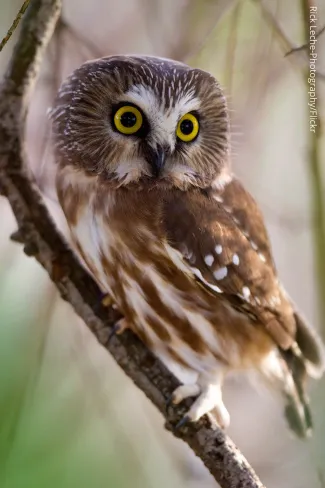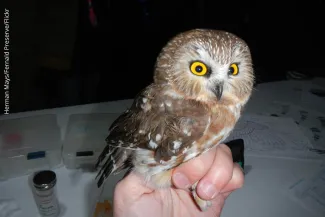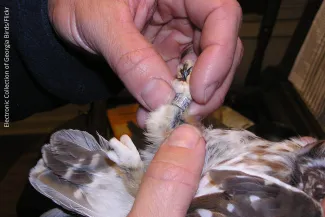The northern saw-whet owl, a fierce predator of deer mice in the United States' northern forests, has only been documented 15 times in Oklahoma prior to 2016. Last fall, researchers with Northeastern State University established Oklahoma's first saw-whet owl banding station and more than doubled that number. The Oklahoma researchers hope to learn more about these migratory bird's movements as their project continues.
"It’s hard to look fierce and menacing when you weigh less than 3 ounces.”
But somehow the northern saw-whet owl manages. Noted conservationist Kenn Kaufman has found the perfect way to describe the highly migratory owl – especially from the perspective of the deer mice frequently hunted by the tiny owls.

“These owls are even smaller than the more common screech owl,” said Mia Revels, Northeastern State University professor. “When you have them in hand, they have a giant head and really muscular legs.”
Revels, NSU graduate student Abbey Ramirez, and undergraduate field technician Laura Hulbert, began studying the owls in Cherokee County in the fall of 2016, partnering with The Nature Conservancy to establish Oklahoma’s first northern saw-whet owl banding station. By the end of their first season, the “Owl Gals” had effectively changed the way biologists view saw-whets in Oklahoma.
Prior to their research, only 15 Oklahoma saw-whet owl records existed. By late November, 2016 the team had more than doubled this number, capturing, banding and releasing an additional 18 migrating owls over a 23-day period.
Capturing The Elusive Saw-whet Owl
The idea of capturing and banding saw-whet owls in Oklahoma took shape in 2015 when Revels attended an Oklahoma Ornithological Society meeting held in conjunction with the Arkansas Audubon Society meeting. There, she learned of University of Arkansas’ Dr. Kimberly Smith and his student Mitchell Pruitt’s successful efforts to capture and band saw-whet owls in their state.

“Seventy miles separate Arkansas’ owls from Tahlequah, Oklahoma,” said Revels.
After that meeting, Revels began preparing for a similar research project in Oklahoma. Northeastern State University agreed to purchase most of the necessary equipment, including long nets with a number of “pockets” that are extended several feet in the air, and The Nature Conservancy provided the study site.
Graduate student Ramirez and technician Hulbert came onboard with the project and began stretching 12-meter nets in the study site’s oak/pine-mix forest on the night of October 20, 2016.
“We stretched four nets 30 minutes after sunset each night we attempted to trap owls, and had the nets deployed until at least midnight.” Immediately after stretching the net, the crew put a speaker on the ground in the center of the net to serve as an “audio lure.” This speaker played the saw-whet call, a whistled “too-too-too” that repeats at a rate of two notes per second.
“We had been in the field for three weeks, stretching our nets night after night, before we captured our first saw-whet owl.” A hatch-year female, one born that year, was captured on November 4.
The research team collected several data points with each owl capture. “We documented the time of capture, the direction the owl had been flying, which of the four nets it was captured in and in which net pocket, as well as the air temperature, wind speed and cloud cover.”
Captured owls were temporarily placed in a small holding bag and shuttled to The Nature Conservancy’s preserve headquarters one-half mile away. There, the birds were weighed and banded with a unique identifying number before being aged.

Feathers grown in the current year fluoresce under black light. “For hatch year birds, all their feathers are new and have a pigment called porphyrin, so they fluoresce bright pink,” said Ramirez.
Researchers are able to tell how old the birds are based on the amount of pink that shows under black light. “We can only age birds as ‘hatch year’, ‘second year’, and ‘after second year’ with this technique.”
Eleven of the 18 birds captured through this project were classified as “hatch year,” three were “after second year” birds.
The Oklahoma research team has already observed incredible movements during the saw-whet’s migration. “Two of the birds we captured had already been banded by other researchers,” Ramirez said.
“We captured our first previously banded bird on November 5, our second successful owl night.” The second year female was initially banded by Canadian researchers near Port Rowan, Ontario more than a year before.
The following night, the second previously banded bird was captured in an Oklahoma net. “The hatch year male had been captured and banded near Duluth, Minnesota on the last day of September." The bird had flown more than 800 miles south in a mere 37 days.
So far, none of Oklahoma’s banded owls have been captured by other researchers.
The "Owl Gals" plan to learn more about these traveling owls by continuing research this fall. In addition to banding more owls, they hope to experiment with issues related to wind and lunar illumination by placing one banding lane in an open location and one in a more protected location.
More information about this research project can be found at projectowlnet.org.